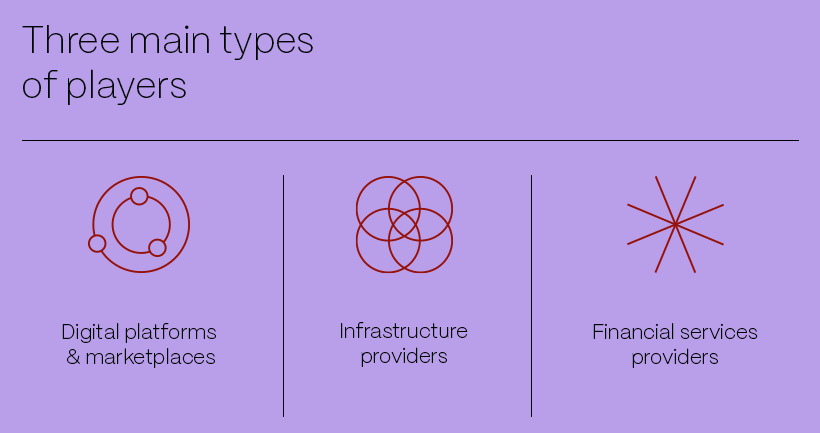What are the key considerations for FinTechs and financial service providers entering the embedded finance market?
The embedded finance market is estimated to grow at a CAGR of 16.4% from 2022 to 2032, reaching $248.4 billion

Embedded finance refers to the integration of financial services into non-financial products or services. This allows for seamless and convenient access to financial services, such as you buying that cool lava lamp you wanted, or travel insurance from your online travel agent. This integration enables businesses to offer financial products and services such as payments, insurance, lending and investment / wealth management to their customers without requiring them to visit a financial institution.
In a nutshell, embedded finance ensures you as a consumer have everything you need for a seamless experience every time you are transacting on a digital platform. For example, an e-commerce platform may offer payment processing and lending services to its customers, or an app such as Uber may provide insurance and investment products to its drivers.
Who participates in the value chain when it comes to embedded finance?
There are three key players that work together in the embedded finance value chain: digital platforms and marketplaces, infrastructure providers, and financial services providers.

Platforms and marketplaces are typically software firms or retailers, digital platforms, or other types of companies embedding the financial service into the overall customer experience or offering.
Infrastructure providers do exactly what it says on the tin - they are there to provide the technology and infrastructure for delivering financial products to platforms and marketplaces via APIs.
Financial services providers offer the financial services being embedded and provide platforms/marketplaces with access to regulated licenses, funds, risk frameworks, and storage for deposits. They are typically banks, small financial institutions, insurance providers, and lenders.
The embedded finance market is estimated to grow at a CAGR of 16.4% from 2022 to 2032, reaching $248.4 billion, according to Future Market Insights. Fintech companies are expanding in the insurance markets at a high pace enhancing the innovative platforms building contextual products and services, we are witnessing an increase in acceptance of real-time payment systems acting as platforms for innovation, and more personal and small and medium-sized enterprises lending. These are considered the main drivers of growth of the embedded finance market.
Why should FinTechs and financial service providers enter this market?
The embedded finance market is very lucrative. There is already good traction and product offering among financial institutions that provide embedded finance products through APIs, and the leaders are already emerging.
However, the market is still in its early stages, meaning there is an opportunity for fintechs and financial institutions to develop innovative and compelling offers.
Here are some of the reasons why now is the perfect time to enter the market:
You’ll get access to new customers
By partnering with non-financial businesses, fintechs and financial services providers can reach new customer segments who may not have been interested in traditional financial products or services. Embedded finance makes it more convenient for customers to access financial services.
You’ll steadily increase revenue
The embedded finance market gives you the opportunity to grow your revenue through increased transaction volume, new customer acquisition, and cross-selling of financial products. If you’re a fintech and a financial service provider, you can earn revenue by providing payment processing, lending, insurance, or other financial services within the products or services of their partners.
You’ll directly impact customer experience
Embedded finance can provide a seamless customer experience, where financial services are integrated into the products or services that customers are already using. This can lead to increased customer satisfaction and loyalty.
You’ll gain a competitive advantage early on
Entering the embedded finance market can provide fintechs and financial service providers with a competitive advantage over traditional financial institutions. By partnering with non-financial businesses, you can offer more innovative and convenient financial services.
How to succeed in the embedded finance market?
To be successful, fintechs and financial services providers looking to offer embedded-finance products to platforms and marketplaces need to:
- Choose their strategy
- Build a smooth experience for developers
- Develop capabilities to support platforms and marketplaces, and their customers
- Put in place solid support services for risk control and regulatory compliance
Choosing your strategy
For banks, insurance companies, and payment service providers with their own well established distribution channels, embedded finance introduces cannibalization risk as embedded finance products going through the platforms and marketplaces would compete with their own channels.

On the other hand, for financial institutions that have limited market reach with their own channels (e.g. local or regional players), embedded finance would be a very attractive way to expand their market reach and revenues.
So far, the first movers were payment infrastructure providers. They are leading the growth by leveraging their money transfer services to attract platforms and marketplaces, and once established, moving up the value chain into lending and other products that the banks have traditionally dominated.
You would need to choose the right strategy for your specific business case but also be prepared that some cannibalization might be necessary to reach new revenue streams.
Building a smooth experience for developers
Many traditional financial institutions find it challenging to externalize their processes through APIs that allow platforms and marketplaces to integrate embedded-finance products in a smooth and seamless way into their distribution platforms.
A good developer experience that allows for scale-up requires two main things:
- Self-service access
- APIs with solid documentation
Without those, you risk miscommunication, increasing your time-to-market, and wasting your resources.
Developing capabilities to support platforms and marketplaces, and their customers
Financial institutions and fintechs will need to ensure they have the capability to support platforms and marketplaces in selling embedded-finance products to their retail or business customers.
This can be done in several ways:
- Providing access to capital (e.g. loans, deposit storage)
- Ensuring digital payment solutions (e.g. mobile wallets, online payment platforms)
- Streamlining processes (e.g. automating payment processing, inventory management, and other administrative tasks)
Put in place solid support services for risk control and regulatory compliance
Platforms and marketplaces distributing embedded-finance products will likely not be able to build, sell and support financial products in a risk-controlled and regulatory-compliant way. Based on time-to-market pressure, they are unlikely to have an appetite to build those capabilities. Accordingly, they will turn to financial services and infrastructure providers for expertise and tools to deliver embedded-finance products in a compliant way.

Maximizing value and minimizing risk in the embedded finance value chain
Embedded finance has opened up the revenues from the lucrative financial services market to other non-financial players such as software developers, retailers and professional service providers.
Continue readingLooking for someone to help you with embedded finance offerings?
If you are a financial services provider building innovative embedded finance products or a platform/marketplace that wants to integrate them into your offerings, we have the expertise and experience to help you deliver.
We’ve worked on projects across Europe, UAE, and the USA, and many of our clients have been working with us for years. It means we’ve built up a huge amount of expertise across industries, including complex, tightly regulated sectors such as fintech.
Let’s connect and chat about how we can make a difference together: contact us today!


